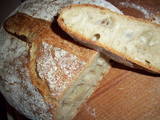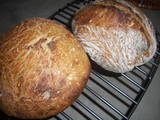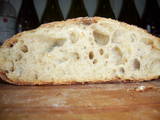
Pain au Levain (Two ways)

 Hamelman's Pain au Levain
Hamelman's Pain au Levain

 Reinhart's Pain au Levain
Reinhart's Pain au Levain
More recently, I have being doing a comparative analysis on two different kinds of Pain au Levain’s. The two Pain au Levain’s, I have been working on over the coarse of last few days were Jeffery Hamelman’s Pain au Levain (sourdough bread) from Bread- a baker’s book of techniques and recipes, and Peter Reinhart’s Pain au Levain from Peter Reinhart’s artisan breads everyday.
Having said that let me start with Hamelman’s Pain au Levain that had an interesting new twist that was different from the previous three sourdough breads that I have baked. The final build (Levain build) is basically built 12 hours before the final dough. Usually, I have noticed in Reinhart’ several recipes including his version of Pain au Levain that the starter is built only about to 6 to 8 hours or even lesser period before the final build. Another difference between the two Pain au Levain’s was that Hamelman’s version required some rye flour other than the bread flour, and Reinhart’s version required whole-wheat flour other than the bread flour. Although, Hamelman does have another recipe where he uses whole-wheat instead of rye. Frankly, speaking it doesn’t really matter much, I mean Pain au Levain is naturally leavened bread, which usually requires some amount of whole grain and that could be substituted with any whole grain such as rye or whole-wheat.
Another major difference between the two recipes was the different autolyse periods. Hamelman preferred anywhere from 20 to 60 minutes, while Reinhart insisted on just about 5 minutes. Also, Hamelman prefers to mix his levain build right after the autolyse period into the so called final dough, unlike Reinhart who asks to cut the levain build into 10 to 12 pieces and mix it with the final build, only then leaving it for an autolyse period after that.
The other variance I observed between the two recipes was the bulk fermentation periods. In Hamelman’s recipe, the period was for 2 and half hours, where in-between you had the folding to be addressed after every 50 minutes. While in Reinhart’s recipe the so-called bulk fermentation was for 40 minutes, where in he asked to fold the dough at every 10 minutes. Of course in Reinhart’s case he asks you to put the dough back into refrigeration for 8 to 12 hours for some more delayed fermentation and then a final fermentation on baking day at room temperature for 2 to 3 hours. In Hamelman’s recipe the final fermentation takes place the same day as bulk fermentation for 2 and half hours.
As per baking is concerned, I took a new route on both the loaves, unlike what their authors had suggested. Having recently read Tartine by Chad Robertson and also having experimented several times with Jim Lahey’s No Knead breads, I personally have come to the conclusion that atleast in my oven the best approach to get a good crust can only be reached through the process of a dutch oven. Thus, I decided to bake both the Pain au Levain’s in the dutch oven.
In my conclusion, I would write that both the Pain au Levain’s turned out excellent with probably one of the better crusts in recent baking, thanks to the dutch oven. As per the crumb, I thought both were delightful, though I think I may prefer the whole-wheat over rye, but then that could purely be to the reasons that I have had more whole-wheat in my life than rye. The other problem, I had faced more so with Reinhart’s dough was that it was a really wet dough, it had a hydration rate about 68.12%, while Hamelman’s recipe which had a 65% hydration rate was in some ways slightly easier to work with. In the end it is hard to say, which was a better recipe, but if I have to go back and choose from the two, it would probably be Hamelman.


Comments
How would you compare the 2 crumbs?
It looks like the Reinhart was nice and open so did you get a similar result with the other recipe?
Either way both your breads look great.
I would have to say the crumb, it was equally good. I mean personally, I do have a bias with whole-wheat so maybe Reinhart...but Hamelman's was equally good too.
-Raj
Hamelman and Reinhart both know how to arrive at a delicious bread, even when using different techniques. Looks like you are making good strides with each.
Paul
Indeed, they are both masters of good bread. Just today, I made another Reinhart 100% Whole Wheat Hearth bread and it turned out pretty good, I look forward to put another blog on that soon.
-Raj
Nice looking loaves, and I like the idea of comparing two similar breads. Obviously there was no great difference in taste. I prefer Reinhart's method (less kneading, more cold fermenting), but it's good to know that you can interchange methods, to better fit your schedule.
Karin
It is true, with Reinhart's method majority of the fermentation happens in the fridge. However, with Hamelman's method it cuts short the total process time of making the bread- since the bulk fermentation and the final fermentation happen on the same day. Though, Reinhart also suggests that option, he certainly insists towards refrigeration.
-Raj